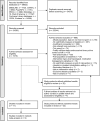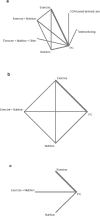Interventions to prevent the onset of frailty in adults aged 60 and older (PRAE-Frail): a systematic review and network meta-analysis
- PMID: 39060779
- PMCID: PMC11614966
- DOI: 10.1007/s41999-024-01013-x
Interventions to prevent the onset of frailty in adults aged 60 and older (PRAE-Frail): a systematic review and network meta-analysis
Abstract
Purpose: Frailty in older adults is associated with multiple adverse health outcomes, while evidence on its successful prevention has been scarce. Therefore, we analyzed the effectiveness of different interventions for the prevention of frailty onset.
Methods: In this systematic review, eight databases were searched for randomized controlled trials of interventions in non-frail (i.e., robust or pre-frail) adults aged ≥ 60 years that assessed frailty incidence at follow-up. Additive component network meta-analysis (CNMA) was conducted to isolate the effect of different intervention types on the main outcome of frailty incidence, reporting relative risk (RR) with 95% confidence intervals (CI). The effect on gait speed was analyzed as an additional outcome using a classic network meta-analysis and the standardized mean difference (SMD) with 95% CI.
Results: We screened 24,263 records and identified 11 eligible trials. Nine trials (842 participants, all categorized according to the physical phenotype) in pre-frail (seven RCTs) and robust/pre-frail (two RCTs) older adults were included in the CNMA. Physical exercise significantly reduced frailty incidence at follow-up (RR 0.26, 95% CI 0.08; 0.83), while this was not found for nutritional interventions (RR 1.16, 95% CI 0.33; 4.10). Interventions based on physical exercise also improved gait speed (SMD 1.55, 95% CI 1.16; 1.95). In addition, 22 eligible trial protocols without published results were identified.
Conclusion: Interventions based on physical exercise appear to be effective in preventing the onset of frailty in older adults. Although the available data are still limited, results from ongoing trials may add to the body of evidence in the foreseeable future.
Keywords: Frailty prevention; Geriatrics; Older adults; Pre-frailty.
© 2024. The Author(s).
Conflict of interest statement
Declarations. Conflict of interest: The authors declare no conflict of interest. Ethical approval: Since this review consists of publicly available materials, it did not require ethical approval. Informed consent: Not applicable.
Figures



References
-
- Fried LP, Tangen CM, Walston J, Newman AB, Hirsch C, Gottdiener J et al (2001) Frailty in older adults: evidence for a phenotype. J Gerontol A Biol Sci Med Sci 56(3):M146–M156. 10.1093/gerona/56.3.m146 - PubMed
-
- Kojima G (2017) Frailty as a predictor of disabilities among community-dwelling older people: a systematic review and meta-analysis. Disabil Rehabil 39(19):1897–1908. 10.1080/09638288.2016.1212282 - PubMed
-
- Kojima G, Iliffe S, Jivraj S, Walters K (2016) Association between frailty and quality of life among community-dwelling older people: a systematic review and meta-analysis. J Epidemiol Community Health 70(7):716–721. 10.1136/jech-2015-206717 - PubMed
-
- Collard RM, Boter H, Schoevers RA, Oude Voshaar RC (2012) Prevalence of frailty in community-dwelling older persons: a systematic review. J Am Geriatr Soc 60(8):1487–1492. 10.1111/j.1532-5415.2012.04054.x - PubMed
-
- Reeves D, Pye S, Ashcroft DM, Clegg A, Kontopantelis E, Blakeman T et al (2018) The challenge of ageing populations and patient frailty: can primary care adapt? BMJ 362:k3349. 10.1136/bmj.k3349 - PubMed
Publication types
MeSH terms
Grants and funding
LinkOut - more resources
Full Text Sources
